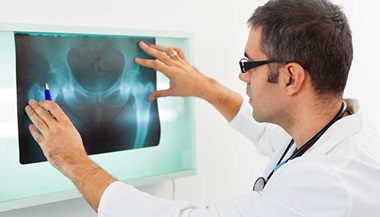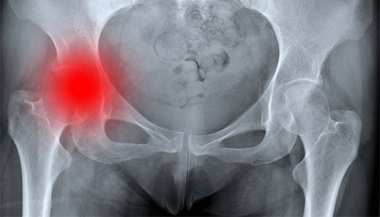Hip Pinning
What is hip pinning?
A hip pinning is a type of surgery to fix a broken (fractured) hip. Another name for hip pinning is fracture repair and internal fixation. Hip pinning uses pins, screws, or plates to help hold broken bones together so they can heal correctly.
Your thighbone (femur) meets with your pelvis at your hip joint. This joint is called a ball-and-socket joint. The socket is a cup-shaped structure on your pelvis called the acetabulum. The ball, or head, is the rounded upper end of your femur. Cushions of tough flexible tissue (cartilage) protect the inside of the acetabulum and the surface of the head. A fluid-filled capsule surrounds the joint. A neck connects the head of your femur to its long shaft. At the top of shaft, just before the neck, is a bump called the greater trochanter. A smaller bump, called the lesser trochanter, sticks out from the underside of the area where the shaft and neck meet.
A hip fracture is a break in the upper part of your thighbone. It may include the top of the shaft, the neck, or the head.
During your hip pinning, your surgeon will make a cut (incision) in your skin to reach the broken bone and put the pieces back in place. Once your surgeon has put the pieces back in the right place, he or she will use pins or screws to hold them together. Your surgeon also might use a metal plate to help reinforce the broken area.
Why might I need a hip pinning?
You might need a hip pinning if you have had a broken hip. Hip fractures often must be fixed with surgery. Depending on the type and complexity of your break, as well as your health, you may need either a hip replacement or a hip pinning.
In general, if you have a break that involves the head and neck of the femur (intracapsular fractures), you are likely a good candidate for hip replacement or pinning. Based on the nature of the break and how much the bone has moved out of place, the blood supply to the head of the femur may be damaged. This can lead to death of the bone in that area. The term for this is avascular necrosis. It is most common in older adults. A hip replacement can prevent problems such as arthritis that may happen because of avascular necrosis.
Hip pinning is a treatment choice in younger adults and children. It’s also good for hip fractures that happen between the greater and lesser trochanter (intertrochanteric fractures). Other types of implants are more typical for breaks that are farther down the leg (subtrochanteric fractures).
Hip fractures often occur because of falls or some other form of blow to the hip. Health problems that raise the risk for falls include:
-
Dementia
-
Visual problems
-
Dizziness
Conditions such as osteoporosis, cancer, and repetitive stress injuries also can weaken bones. That can increase your risk for hip fracture.
What are the risks of hip pinning?
The goal of hip pinning is to put the bones back into place so they can heal the right way. It will also reduce your pain and help you to get up and move around again. As with any surgery, sometimes complications may occur. These may include:
-
Infection
-
Bleeding
-
Blood clots
-
Injury to nearby nerves
-
Improper or incomplete healing of the femur
-
Limping because of changes in leg length
-
Arthritis
There is also a risk that the procedure might not get rid of your pain. Or it might cause new pain. Your own risk of complications may vary based on your age and any other health problems. Ask your healthcare provider about the risks that most apply to you.
How do I get ready for a hip pinning?
Your medical team can tell you how to get ready for your surgery. Before your surgery, it is important to give a history of all your health problems. Let your healthcare provider know if you have any medicine allergies. Also let him or her know if you have a more recent problem, like a sudden fever. Tell him or her if you are pregnant or think you might be pregnant.
Discuss any medicines you may be taking. That includes over-the-counter medicines and supplements. Ask if you need to stop taking any of these before your surgery.
In some cases, your healthcare provider might want more tests before your surgery. These might include:
-
X-rays, a CT scan, or a MRI study, to look at the bones of your hip and for signs of injury to nearby tissues
-
Chest X-rays and electrocardiogram, to make sure your heart and lungs are normal
-
Blood tests, to check how much you have bled and to look at your body chemistry
-
Urinalysis, to look for signs of infection and to cut the risk for infections after your surgery
You will likely need to avoid eating and drinking until after your surgery is done.
What happens during a hip pinning?
The details of your hip pinning surgery will depend on the nature of the injury and the way your healthcare provider will do the surgery. An orthopedic surgeon and special nurses will do the surgery. An anesthesiologist will make sure you don't feel pain during the surgery. The surgery may take a few hours. Talk with your healthcare provider about what to expect. In general:
-
You may get general anesthesia so you can sleep through the surgery. If you get regional or local anesthesia, you may also get medicine to make you feel relaxed and sleepy.
-
Your heart rate, blood pressure, and other vital signs will be carefully watched before, during, and after the operation.
-
You may get antibiotics to help prevent infection.
-
The surgeon makes a cut (incision) over the outside of your hip, cutting through your skin and muscle.
-
If the bone fragments are not lined up properly (displaced), the surgeon will line them up. This step is called a reduction.
-
The surgeon may place a plate alongside the bone fragments.
-
The surgeon uses pins or screws, or a combination, to attach the bone fragments together. If the surgeon is using a plate, he or she will use pins to attach the plate to the fragments.
-
The surgeon or an assistant will close up your skin.
What happens after a hip pinning?
After your surgery, you will go to a room for monitoring while your anesthesia wears off. You will get medicine to ease pain. You may get medicine for nausea if needed.
After your initial recovery, you will go to your hospital room. You should be able to start eating and drinking again slowly. You may need to wear stockings or plastic devices to help prevent blood pooling in your legs. You may need to take medicine to prevent blood clots. You may be taught how to do breathing exercises and coughing to help prevent pneumonia.
Your healthcare provider may decide to get an X-ray or another imaging study to look at your hip. You may also need tests to check your blood or urine.
You may notice some drainage from your incision for the first few days. Tell your healthcare provider right away if you have:
-
Increased redness
-
Swelling
-
Drainage
-
High fever
-
Severe pain or pain that does not improve
Your healthcare provider will tell you when to start moving around and how much weight to put on your leg. He or she may instruct you to not put your full weight on your leg at first. You may stay in the hospital a week or so while your hip starts to heal. Depending on how you do, you may be able to go home. Or you may need to go to a rehabilitation or nursing facility.
Your provide may give you instructions on what types of activities you can and can’t do. As you start to get around, you may find that you need to use a cane or crutches. You may also need to work with a physical therapist to regain your mobility and strength.
You should be able to do light activities within a couple of weeks. During this time, it may be helpful to have extra help.
Keep all your follow-up appointments. Follow all your healthcare provider’s instructions. If you have external stitches or staples, they will be removed a week or so after your surgery.
Next steps
Before you agree to the test or the procedure make sure you know:
-
The name of the test or procedure
-
The reason you are having the test or procedure
-
What results to expect and what they mean
-
The risks and benefits of the test or procedure
-
What the possible side effects or complications are
-
When and where you are to have the test or procedure
-
Who will do the test or procedure and what that person’s qualifications are
-
What would happen if you did not have the test or procedure
-
Any alternative tests or procedures to think about
-
When and how will you get the results Who to call after the test or procedure if you have questions or problems
-
How much will you have to pay for the test or procedure






